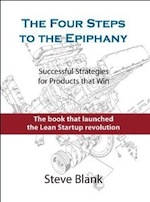There is nothing really new with Steve Blank’s 5th edition of The Four Steps to the Epiphany. But first I lost my first copy (who has it?) and second I thought I should read again this bible for entrepreneurs. So why not a second look.
Ten years after the 1st edition, Blank is as right as ever. His Customer Development model is a great lesson about the dangers of business plans and of product development without some validation form early customers and the Market. You can read my post from 2011, Steve Blank and Customer Development. You should, as I will not say again what I said then. I do not have much to change. Let me just say again a few key elements:
– “The good new is these customer and market milestones can be defined and measured. The bad news is achieving these milestones is an art. It’s an art embodied in the passion and vision of the individuals who work to make their vision a reality. That’s what makes startups exciting.” [Page 22 and see note (1) below]
– Start-ups are not early versions of established companies. they have nothing to do with them in fact. “Startups are temporary organizations designed to search for a scalable and repeatable business model.” As a consequence, people running start-ups (product, sales, marketing, management) need to understand the start-up culture and dynamics. “Traditional functional organizations [Sales, Marketing and Business Development] and the job titles and the job descriptions that work in a large company are worse than useless in a startup. They are dangerous and dysfunctional in the first phases of a startup.”[Appendix A, “The Death of the Departments”.]
Blank’s Four Steps to the Epiphany is not easy to read but it is a must have and a must read for any entrepreneur!
(1) In another interview Balnk explained: Over the last decade we assumed that once we found repeatable methodologies (Agile and Customer Development, Business Model Design) to build early stage ventures, entrepreneurship would become a “science,” and anyone could do it. I’m beginning to suspect this assumption may be wrong. It’s not that the tools are wrong. Where I think we have gone wrong is the belief that anyone can use these tools equally well.” In the same way that word processing has never replaced a writer, a thoughtful innovation process will not guarantee success. Blank added that ” until we truly understand how to teach creativity, their numbers are limited. Not everyone is an artist, after all.”

